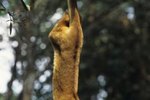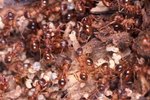
Armadillos are from the Dasypodidae family and are near kin to both sloths and anteaters. They have conspicuously tiny eyes and vision is far from their strong suit. They make up for that, however, by having admirable olfactory abilities. The armadillo world consists of 20 species, including the nine-banded armadillo (Dasypus novemcinctus) and the giant armadillo (Priodontes maximus).
The Armadillo Nose
The armadillo nose -- or snout -- is the key to their food finding success. Their noses are hard to miss, as they're somewhat reminiscent of shovels in outline. Since they can't see well, their snouts are the tools they use to track down their favorite foods. Armadillo food searches typically take place either first thing in the morning or at the end of the day.
Digging for Meals
Armadillo noses are so powerful that they often actually allow the mammals to pick up on smells that are tucked away under roughly 6 inches of dirt. When they find something to eat that's deep in the dirt, they don't hesitate to get it out via their lengthy and massive front claws. People sometimes view armadillos as annoyances for this reason. Armadillos occasionally wreak havoc on agricultural crops when they persistently dig around for their next meal.
Armadillo Diet
Insects constitute most of what armadillos eat. Some of their preferred insect fare includes ants, termites and beetles, although they don't limit their sustenance to those. They also routinely munch on the larvae of insects. Outside of insects, armadillos also sometimes dine on slugs, worms, eggs, arthropods, reptiles, amphibians and carrion. They even eat berries, fruit and some plants once in awhile.
How Armadillos Hunt
When armadillos are on foraging quests, they require substantial space. It's totally common for armadillos to travel between 5 and 10 acres during the course of a night tracking down suitable food. Their elongated snouts guide them in their hunts. They place their snouts over the ground and continue moving to the front. Doing this creates grooves in the soil that enable them to sniff around for their next prey. When they finally identify something they want, they employ their gooey tongues to secure it. Their talented tongues can seize a maximum of 60 insects in single instances.
References
- SeaWorld Animal Bytes: Nine-banded Armadillo
- Texas Parks & Wildlife: Armadillos
- Animal Planet: Armadillos
- The Astonishing Armadillo; Dee Stuart
- Colorado Parks and Wildlife: Nine-Banded Armadillo
- The University of Georgia Cooperative Extension: Armadillos
- National Geographic: Armadillo
- The Armadillo; Steve Potts
- University of Missouri Extension: Armadillos an Unwanted Garden Pest
- Natural Science Research Laboratory: Nine-banded Armadillo
Photo Credits
-
Tom Brakefield/Stockbyte/Getty Images




